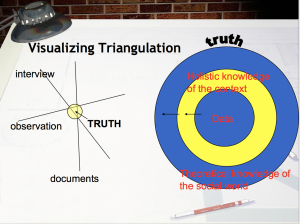Participant observation is a central data collection strategy in much interpretive and critical research. This article <participant-observation> is a quick overview of PO–why and how it is done, and some cautions as well.
Category Archives: methods
technology and qualitative research
This special issue of Forum: Qualitative Social Research covers a range of topics in digitizing information for and in interpretive research.
An introduction to image based research
Triangulation
A key strategy for establishing the veracity of interpretive/critical research is triangulation. The term is over-used and often mis-used. Many researchers imply that triangulation will lead to the truth by eliminating bias and is not based on the presumption that there is indeed a single truth to be gotten to (image on the left), but in reality the value of triangulation is more nuanced. Sometimes, data from different sources or collected by different methods do converge, but often they are inconsistent or even contradictory. Convergence is not more analytically useful (or closer to the truth) than inconsistence or contradiction. Triangulation provides the researcher with rich data from which to discern meaning, but this is a task for the researcher not an inevitable result of using a technique (image on the right). For a more thorough discussion of what this means and some examples, click on the article link below.
Virtual Ethnography
The increased use of virtual space as a cultural site for communication and social interaction opens a new space for social inquiry. The latest issue of the Forum: Qualitative Social Inquiry is devoted to this topic.
This peer reviewed journal is completely online and is truly international in its scope, indeed articles are available in several languages. You can subscribe to the journal and will get an email when each issue is published.
Essence of Grounded Theory
A Very Crude & Brief Overview of Some Major Methodologies
Open space technology
“Open Space Technology is one way to enable all kinds of people, in any kind of organization, to create inspired meetings and events. Over the last 20+ years, it has also become clear that opening space, as an intentional leadership practice, can create inspired organizations, where ordinary people work together to create extraordinary results with regularity.
In Open Space meetings, events and organizations, participants create and manage their own agenda of parallel working sessions around a central theme of strategic importance, such as: What is the strategy, group, organization or community that all stakeholders can support and work together to create?”
There are many resources for using open space technologies, but this one is the most comprehensive.
 Follow
Follow


